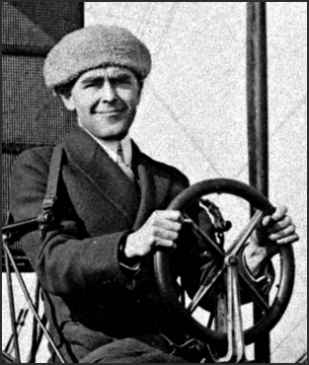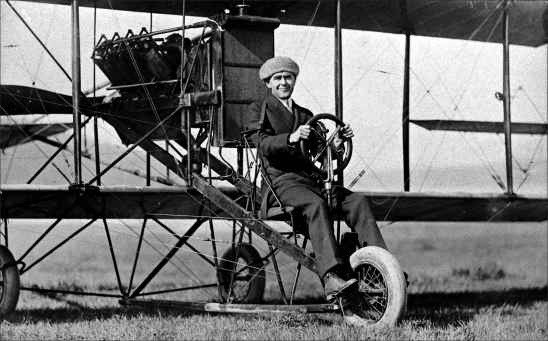
1885-1951 |
 |
Collection of the Kentucky Historical Society Courtesy of Frank Boyett, 8-18-04 |
 |
Collection of the Kentucky Historical Society Courtesy of Frank Boyett, 8-18-04 |
|
By FRANK BOYETT, Gleaner staff February 8, 2004 |
 |
Henderson's first airplane took to the air for the last time 75 years ago.
But it wasn't flying. It was, shall we say, wafting? The plane went up in smoke when the Rash Tobacco Factory at Washington and Water streets burned. That fire also destroyed the old McClain homestead, the city Gas Plant office, and the residence of the plant's assistant superintendent. |
|
"A down-river wind doubtless saved the business district from destruction at an early hour this morning," The Gleaner reported on
Feb. 2, 1929. "Even with a favorable wind the battle was won only by inches and not until several buildings had been swept away in
one of the most spectacular fires in the history of the city."
The fire was discovered about 1:15 a.m. by employees at the Gas Plant, which at that time manufactured gas from coal. The glare from the conflagration woke up half the town. "The entire section of the city was the scene of a near panic as the factory flames lighted the entire city. Residents ran frantically from their homes begging for protection of their property, and spectators ran helplessly not knowing what to do. "Had the fire not been placed under control when it was it would probably have resulted in an explosion that would have wrecked a large portion of the city of Henderson." The public didn't learn that an invaluable piece of aviation history had been lost in the fire until two weeks later on Feb. 15. A story written by Dorothy L. Harris was held by The Gleaner until it could be distributed statewide by the Associated Press. "Henderson's one relic of the early days of aviation, a Curtiss pusher bi-plane belonging to Baxter Adams, pioneer aviator in this section, today lies in ashes, destroyed in the fire which razed the Rash Tobacco Factory here recently," her story began. "Small boys kicking about the ruins occasionally turn up triumphantly with a charred spark plug, ,the skeleton of a wheel, a twisted piece of tubing -- souvenirs of an airplane, the third airplane in the world to loop the loop." I've not been able to independently verify Adams' claim to be the third person to loop the loop, at White Plains, N.Y. Adams also, in a 1936 interview with the Evansville Press, claimed to be the first person in the world to do a 90-degree vertical bank, which involves flying in a circle with the wings perpendicular to the ground. "Up until the time I tried it, it wasn't believed that a plane could fly in that position," he told the Press. Adams got into aviation after watching Horace Kearney do an exhibition flight at the Union County Fair in Uniontown in August of 1912. Adams thought it looked easy and asked Kearney where to learn how to fly. Kearney pointed him toward the Glenn Curtiss training school in Hammondsport, N.Y., which Adams soon entered. In 1914 Adams purchased his 100-horsepower airplane from the Curtiss factory for $5,000 and began his barnstorming career. It was known as a Curtiss biplane pusher because the propellor was in the rear and pushed the plane instead of pulling it. "The machine was built of bamboo, with struts of red, and the linen wings were painted cream -- a sleek shining bird that held its place in the clouds in those early days," according to Harris' 1929 description. "The pilot of this early model sat strapped and unprotected at the front of the machine. There was no protective cockpit to the plane of 1914. In Mr. Adams' words he was a 'witch on a broomstick' when he took to the air. There was no extra seat for passengers." Adams said he earned between $30,000 and $40,000 in his first year of barnstorming, which in 1914 included the first three airplane flights in Henderson. - the last one he crashed the plane and broke his ankle when he failed to clear the Kleymeyer & Klutey brickyard on South Green Street. During World War I Adams served as a civilian flight instructor for the U.S. government at air fields in Chicago and Memphis. The plane last flew in 1919 in Escanaba, Mich. After that Adams broke the plane down and stored it in boxes. It had been stored at the Rash Tobacco Factory about four years at the time it burned. Frank Boyett can be reached at 831-8342 or fboyett@thegleaner.com The original article may be accessed, as long as it exists online, on: The Gleaner |
By FRANK BOYETT Gleaner staff Special Historical Edition of The Gleaner Nov. 28, 1999, He bombed. That doesn't mean he turned in a bad barnstorming performance -- although some might call it that. It means he literally collided with the adjacent Kleymeyer & Klutey brickyard. But let's allow Adams to tell the story in his own words, which he did when he was interviewed by the Evansville Press in 1936. "I was supposed to give an exhibition," said Adams, who was in his late 20s at the time of the flight. "On the first day space was cleared off (at the fairgrounds on South Green Street) for my take off. The motor was started and I perched out in front of it. "All went well for a few seconds. But it soon became apparent that the ship wasn't gaining altitude properly. Above 10 feet it wouldn't budge." That was unfortunate, because the brickyard structure was about 15 feet high. And it was directly in his path. In the ensuing crash, Adams shattered his airplane, one of his ankles and his hopes of impressing the home folks. It was the worst wreck of his barnstorming career. That may be overstating the case a little, since he crashed only one other time. Although the plane suffered fairly severe damage he was able to patch it up and resume his barnstorming. He continued to use the same plane, a Curtiss bi-plane pusher, until he retired from stunt flying. Adams wasn't the first aviator to fly in the Tri-county area, but he was certainly the first of the homegrown variety. Probably the first man to fly in this area was a fellow by the name of Horace Kearney, who put on a flying exhibition at the Union County Fair in Uniontown in August of 1912. Kearney had learned to fly the hard way. He had broken 14 different bones learning to fly, which he began doing about 1909 -- a mere six years after the Wright brothers' historic flight at Kitty Hawk. Kearney was largely responsible for Adams taking up a career as a pioneer barnstormer. "In 1912, I happened to go to a county fair and saw Horace Kearney, a flier for the Curtiss Exhibition Co., stage an exhibition flight," Adams said. "I watched him take off, circle around the field, do a few mild stunts and land. It looked easy. "After the flight I managed to talk to Kearney and learned that he was being paid $600 for the single exhibition flight. I talked with Kearney again and asked him where I could learn to fly. He told me to go to Glenn Curtiss, who was opening a training school for would-be aviators like myself." Adams managed to scrape together a few hundred dollars and was soon on his way to Hammondsport, N.Y., where he enrolled in a class with three other students. "Today a student's first big thrill comes when he solos," Adams said. "But when I was learning to fly we soloed on our first flight. The reason is simple. The planes wouldn't carry more than one person. Since it wouldn't do much good for the student to stand on the ground and watch the instructor fly, the instructor stood on the ground and watched the student fly -- or attempt to fly." First, though, the aviation students practiced on the ground, taxiing and getting a feel for the controls. Once he had the skills to fly, Adams bought his own plane and began a full-time career as a barnstormer. "I cleared between $30,000 and $35,000 the first year," he said. Although Adams is not well-known nowadays as an aviation pioneer, he maintained that he was only the third person in the world to loop-the-loop in an airplane, and was the first to fly in a circle with the wings perpendicular to the ground -- a stunt known as a 90-degree vertical bank. "Up to the time I tried it, it wasn't believed that a plane could fly in that position," he said. Upon his retirement from stunt flying, Adams dismantled his plane and stored it in the Rash Tobacco Factory. Unfortunately, the tobacco factory burned in 1929, the Press reported, and "Henderson lost the first and only airplane owned by one of its citizens up to that time and the world lost a valuable relic of the early days of aviation." Editor's Note: The fascinating article above was kindly submitted to me by Mr. Boyett in response to my request to him to use the following article on Baxter's page. I am very grateful to him, on behalf of my visitors, for enabling me to greatly expand on the career of one of the lesser known pioneers. |
|
By FRANK BOYETT Columnist This story is excerpted from the online edition of The Gleaner Online No longer online (10-7-03) Baxter Adams was the first Henderson County resident to fly an airplane. In 1914 he crashed his plane when he came home to do an exhibition at the Henderson County Fair. In 1925, though, he was living on 12th Street when he had a little adventure. He woke up about 1 a.m. one night to hear his dog making a racket, so he went outside to see what the fuss was about. "While fastening the chain Mr. Adams received an order to halt, the command being followed by a pistol shot," The Gleaner reported. "The bullet went wide of its mark, however, and the would-be assassin fled into the darkness. Police have been unable to find any clue leading to establishment of his identity." |
REQUEST FOR HELP
Baxter Adams married Rodella Alma Carpenter in Oswego, NY, in 1914. There is no mention of his
wife or any children in his obituary, He had no children in either the 1920 or 1930 censuses. They lived in Henderson, and his
occupation was listed as "aviator." Baxter Adams's father was a lawyer with roots in New England. Baxter had one brother who disappears from Henderson in 1911, and there are too many Robert Adamses to attempt to trace. Their mother died in California, so it is possible Robert went there. Baxter's obit didn't mention nieces, nephews, or his brother. I haven't had any luck reaching any family members. There just don't seem to be any. I even got their mother's death certicate from California, hoping to find that Robert was the informant, but the informant was a neighbor. No clues from that! If you find anything at all about Baxter, I would LOVE to have it. |
|
|
|
By Woolner Calisch With brief pauses, the above ejaculations could easily have spanned the duration of the first flight of an airplane at Richmond. I could not very well say "over Richmond," as the maximum altitude is reported to have been 12 feet. This epochal event took place on October 4, 1909, at the State Fairgrounds, when a Curtiss "Golden Flyer" biplane was piloted by Foster Willard, a personal representative of the great aviator and inventor, Glenn H. Curtiss." Editor's Note: These introductory paragraphs were extracted from the entire article which was first published in the Richmond Times-Dispatch Magazine of April 23, 1939. The article is only one of very many which may be found on the Richmond, Virginia - Then and Now, website which offers A Photo History of Richmond, Virginia. In this article you will find mention of many pioneer aviators such as: Foster Willard, (Clarence F. Willard), Glenn H. Curtiss, John Alcock, A. W. Brown, Hubert Fathom, Wilber Wright (Wilbur Wright), Ralph Johnstone, Howard Levin, Professor Hutcheson, George Sewell, Peola, Art Smith and Baxter Adams. If you want to visit the primary source of the article on the net, you can click on the title above. While there you should take advantage of the wealth of other material, both photos and text, which will introduce you to the history of Richmond Virginia. If you prefer, you can read a copy of the article on this website, which includes links to many of the aviators who have pages here. Permission to reproduce the article in its entirety was graciously granted by A. C. Griffith, who is responsible for finding and scanning the original articles, and Karen McLean, who types all of the text into a webpage. We are all very grateful to them for making it available to our online community. You can access it by clicking on: |
|
With regards to Baxter Adams, you will find a very fine photograph of him entitled , "Baxter Adams banking his (Curtiss) aeroplane." You can access it by clicking on: "Dreams of Flying the Atlantic" "Cradle of Naval Aviation" |
via email from Chris Trevillyan, 11-25-05 I was recently doing a search on Google for Baxter Adams and your name came up requesting more information. I am Baxter's great-niece. My father's mother was Baxter's wife's sister. My father often told us stories of spending summers with his Uncle Baxter and playing in his plane that was stored in the barn. I just thought you would like to know that there was still family around. If you know how to contact Susan Jones (she was also mentioned in the google article I read) could you please pass this info along as she was curious if there was more family.. Besides myself, there are 2 other great-nieces, and 2 great-nephews, as well as their children. Hope you found this informative. Chris Trevillyan |
via email from Chris Trevillyan, 11-26-05 My father's name was Ralph Jewell. His mother's maiden name was Pauline Carpenter and one of her sister's was Rodella Alma Carpenter, who married Baxter Adams. As far as I know, Baxter and Rodella had no children. When my father was small, his mother used to send him to Baxter and Rodella's for the summer. They lived in Henderson, Kentucky (I think it was Kentucky). My father was born in 1916 so it must have been in the early 1920's. My father told us he remembered playing in Uncle Baxter's airplane which he kept in his barn. The wings were off and stored in the hayloft but the body was intact. Daddy had a lot of fun playing in it. He remembered Uncle Baxter telling him about his barnstorming days. Dad said that the Wright brothers taught Uncle Baxter to fly. Another interesting side note about Baxter...he was paid by a mining company to shoot at striking mine workers. My father enlisted in the horse cavalry several years before war was declared and lost track of Uncle Baxter. The last he heard was that his house had been sold and became the local high school in Henderson (again, not sure if this is fact). Hope you find this interesting. Chris Trevillyan |
|
FIND A GRAVE |
From the Henderson Gleaner-Journal, 2 December 1951 |
|
If you have any information on this Early Bird, please contact me. E-mail to Ralph Cooper Back 

|